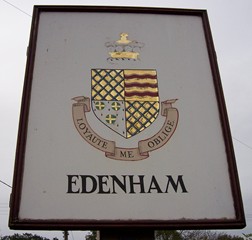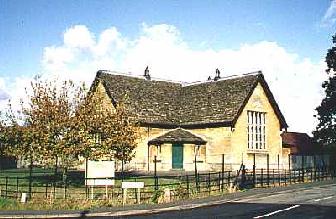|
Edenham
The stately cedar trees in the churchyard at Edenham,
three miles north west of Bourne, were planted more than a century ago and the largest that overhangs the main A151 as you drive into the village from Bourne is thought to be over 150 years old. It has a good straight trunk persisting high through the crown to a spreading, flat top and the canopy is so immense that its branches obscure the first sight of the church’s fine pinnacled
tower, 84 feet high and dating back to the 15th century.
The
cedars here are given added height because the church stands on a man-made
plateau in which Roman remains have been found and nearby are signs of
earthworks, indicating the possibility of Saxon habitation and defences and it
is even possible that an earlier British settlement stood here in this loop of
the River Eden that runs through the parish.
Close by the church is the village school, stone built and sturdy and erected in 1873 as a church school but still providing good service today. It is now administered by Lincolnshire County Council and is known as Edenham Church of England Primary School. An ornate plaque on the front gable end gives the date of the building and the crest of the Willoughby family who lived at nearby Grimsthorpe Castle and who no doubt contributed towards the building costs.
The
family has also been responsible for many acts of philanthropy towards the
parish over the years, notably the provision of a village library. It was first
established in 1844 by Lord Willoughby but it fell into disuse until the summer
of 1874 when it was reopened for the use of the parish under the patronage of
Lady and Miss Willoughby, both having made considerable donations towards the
venture. A total of 400 volumes were then available, a remarkable number at that
time, and it was opened on the first and third Mondays of each month. The
subscription was fixed at as low a rate as possible to attract new members and
by August a total of 86 villagers had already become borrowers.
Not all of our apparently historic public houses are as old as they look and a
good example is the Five Bells at Edenham. It enjoys a reputation as one of our
old English inns but it is in fact Victorian and was not built until 1880. There
was however a temperance hotel on the site prior to that, most probably a
religious hostel similar to those that can be found in the vicinity of many
parish churches to provide accommodation for visitors and within the sound of
their bells. The name indicates that St Michael and All Angels had five bells when the inn was opened in the late 19th century,
the oldest cast in 1636.
The
peal of five were re-hung with new fittings in the summer of 1874 after being
out of order for some time, the work being carried out by Messrs Taylor and Son,
of Loughborough, Leicestershire, and the work paid for by parishioners and Lady
Willoughby de Eresby. An inspection of the peal revealed that the tenor bell
weighed about 13 cwt. and bore the inscription "Thomas Norris made me, 1636" and
was thought to have been made from the metal of a former bell brought from the
Abbey of Vaudey (or as it was then called Valle Dei) close by, the ruins of
which are now in Grimsthorpe Park. The fifth bell was also an ancient one having
been cast in 1726 by the great Peterborough bell maker Henry Penn. The
other three were by Mears, of London, the second and third bearing the date
1807, and the treble 1832. At that time it was also contemplated increasing the
peal to six, there being a frame for that number, but they were not augmented
until 1909 and then to eight in 1931
when the 18th century tenor bell was also recast. A further two treble bells
were added in 1985 following the death of the last Earl of Ancaster two years
before and one of them is inscribed with his initials as a memorial.
To
celebrate the refurbishment of 1874, the Edenham and Bourne societies of ringers
met on Wednesday 12th August and after several hours of ringing, pronounced the
bells to be in admirable condition and afterwards they adjourned to the Five
Bells for a ringers' supper at which the vicar and churchwardens were present.
Edenham
vicarage also acts as a Regional House for the Diocese of Lincoln, serving
parishes and people from the south of the county. It is used for retreats
and reading weekends, family or study days. The Diocesan Educational Team
also meets there periodically for activities such as Sunday School teacher
training and churchwarden days. A new chapel was opened on Friday 15th
June 1990 in the old stables that were last used for their original
purpose 100 years before and had since been utilised as a garage and
potting shed. Grimsthorpe Estate, who own the vicarage, commissioned the
design and various religious charities contributed towards the cost of
furnishings.
The
chapel was dedicated by the Bishop of Lincoln, the Rt Rev Robert Hardy and
the vicar, Canon Andrew Hawes, outlined its aims. "It will be used
to develop the work of fostering and encouraging the spiritual life of the
churches in South Lincolnshire", he said. "The new chapel will
provide a small, warm and flexible space for small groups and individuals
to use and will complement the facilities in the house and the adjacent
church for meetings, study groups and recreation."
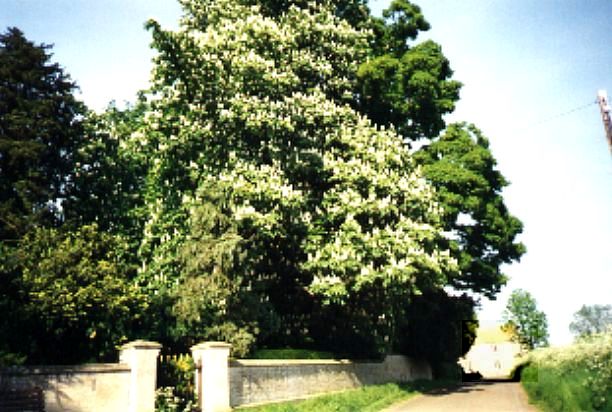
Apart from its famous cedars, Edenham
has many more beautiful trees and we found this one during an evening outing in May 1988. We heard the church bells ringing and stopped to listen and saw this magnificent horse chestnut in full blossom by the side gate to the vicarage. The
church is a
large and handsome building, Early English, Decorated and Perpendicular,
noted for its noble west tower, with a south porch added around 1350 and
decorated with imps, a late 12th century drum-shaped font and many
interesting memorials. Inside the tower are the effigies of a civilian and
lady, circa 1300, and a knight and lady from the late 14th century resting
on an altar tomb.
|
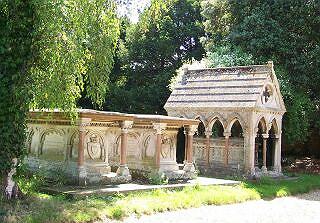 |
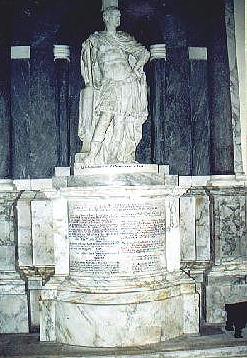 |
|
The church also contains a wealth of monuments to the Dukes of Ancaster, the
Earls of Lindsey and Lords Willoughby de Eresby and other members of the
Drummond family, both in the graveyard and inside the church, many
dating back to the 18th century. |
|
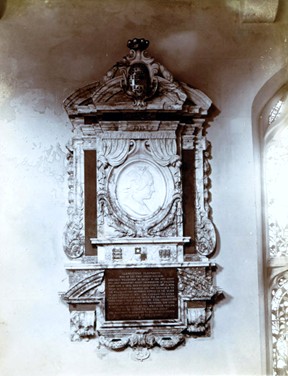 |
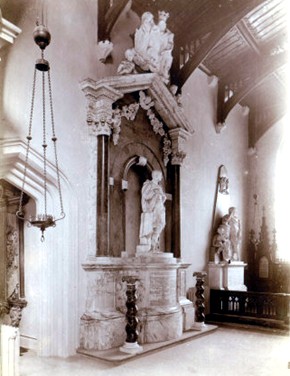 |
|
Photographs taken by William Redshaw of memorials in
the parish church to Clementina Elizabeth, wife of the first Baron Aveland,
Baroness Willoughby de Eresby in her own right and joint hereditary Great
Chamberlain of England. The inscription says:
Born Sept 2 1809, died at Grimsthorpe, Nov 13 1888. After 40 years of
married life, she succeeded to the Willoughby and Drummond estates on the
death of her brother in 1870. She fulfilled the duties of her position
with grace and dignity which arise from a duly noble nature. Kind,
unselfish, and in loving care for others; she lived a long life, beloved
by all who knew her. And so he giveth his beloved sleep.
This monument is dedicated to her in affectionate remembrance by her
children. |
There is a restoration monument in
the north chapel to Robert, 1st Earl of Lindsey and the 12th Baron
Willoughby de Eresby, and a further array in the chancel to
the 1st, 2nd, 3rd and 4th Dukes, by distinguished artists such as
Cheere, Nollekens, Roubiliac and Charles Harris of London, a
series larger than in any other Lincolnshire church, while even
more which commemorate family members can be found in the church
at Spilsby. The family were steadfast supporters of the
Royalist cause in the Civil War and one of the most notable of the
grandiose monuments in the lofty church at Edenham is the huge
monument to Robert Bertie, 4th Earl of Lindsey and 1st Duke of
Ancaster, by the Belgian sculptor Pieter Scheemakers.
|
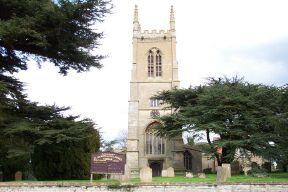 |
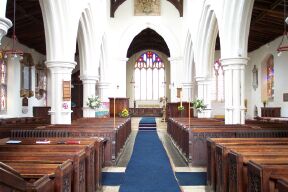 |
|
The church also contains a wealth of old pews
including two bench ends with charming poppy heads while many panels
in the pews themselves were thought to date from the 15th century.
The above photographs of Edenham church were taken in April 2005 when
the future of the pews was being discussed by the parochial church
council. The suggestion was to remove some or all to create more
space for meetings, exhibitions and community activities, which did
not meet with the approval of all parishioners and although most of
the pews were still intact in 2013, several rows are still likely to
disappear although by then a fresh dispute had arisen over the
ancient font which it was proposed to move fifteen feet to a more
central position and so provide more space for family and visitors
at christenings, a decision which again did not please everyone.
The font is Norman, dating from the 12th century, drum shaped with a
stem, the shafts around it having unusual lobed arches, but is
currently tucked away in a corner and crammed in by pews and other
seating.. |
|
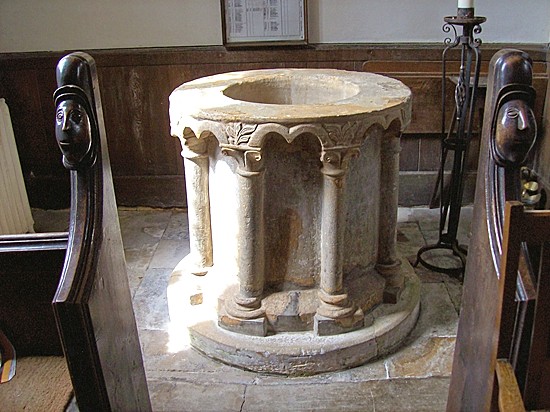 |
|
PHOTO ALBUM |
|
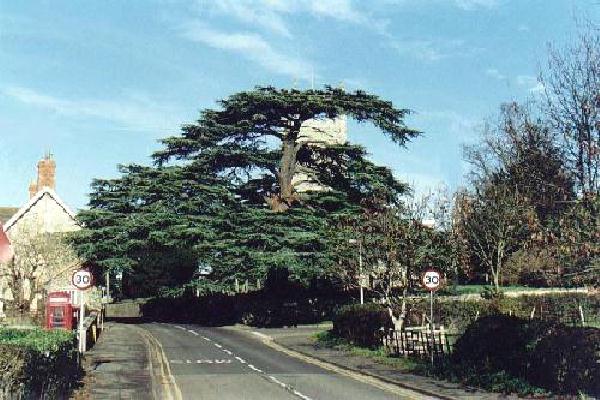 |
|
The 15th century tower of Edenham
church dominates the village while
stately and impressive cedars enhance its appearance, especially for
visitors driving in on the main road from Bourne. |
|
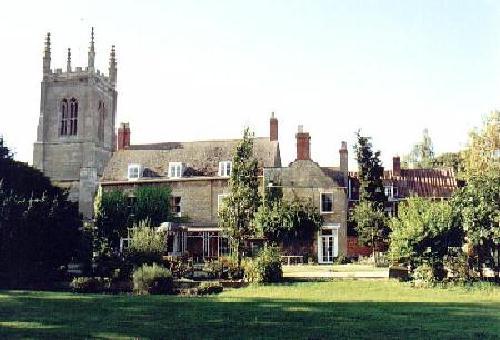 |
|
The
vicarage at Edenham that is also a church retreat.
|
|
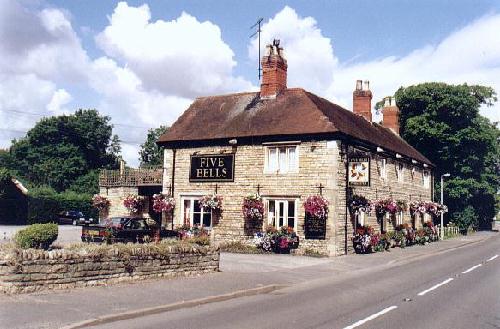 |
|
The Five Bells on
the main road through Edenham.
|
|
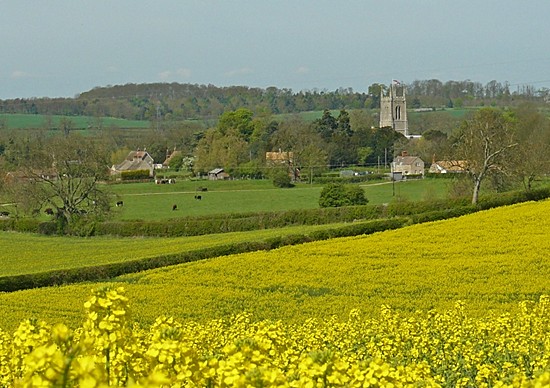 |
|
Edenham village church photographed from the public
footpath from Bourne on St George's Day, 23rd April 2010, with the
national flag flying from the tower. |
|
 |
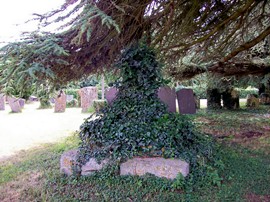 |
|
The stone cross that once stood in the
middle of the village was removed to the churchyard when
threatened by
modern traffic flows and now
has a place
underneath one of
the cedar trees near the main
entrance to
the church. It has been neglected in recent years and in
July 2013 the entire monument had been obscured by ivy. |
|
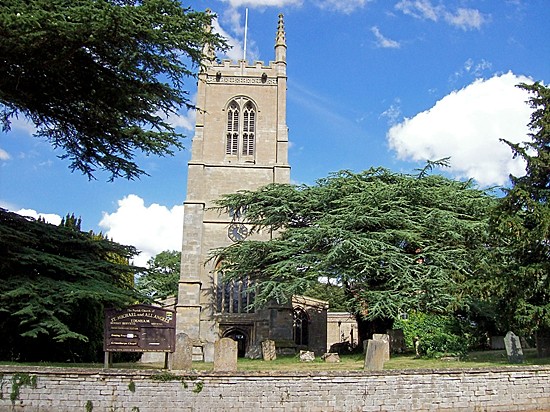 |
|
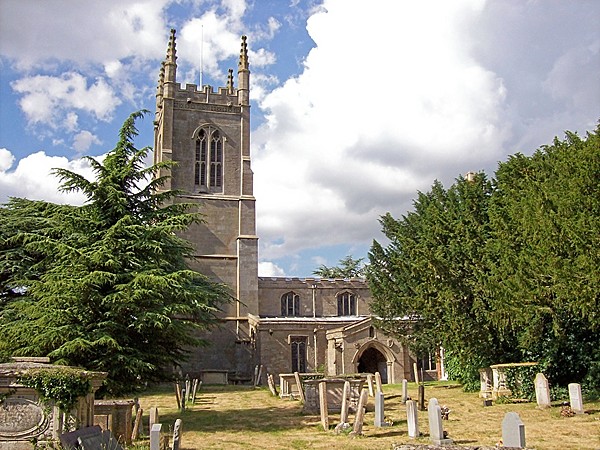 |
|
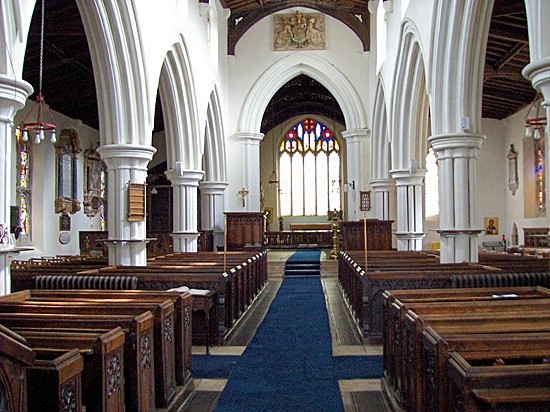 |
|
EDENHAM IN PAST TIMES
|
|
 |
|
This photograph (above) by William Redshaw is taken
from an album of views
of the Bourne area sold by J T Morris who had
shop premises in West
Street and dates from circa 1890. |
|
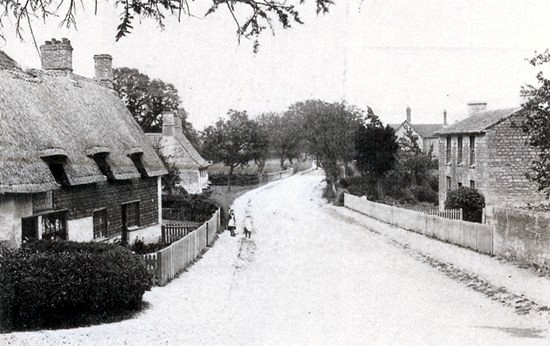 |
|
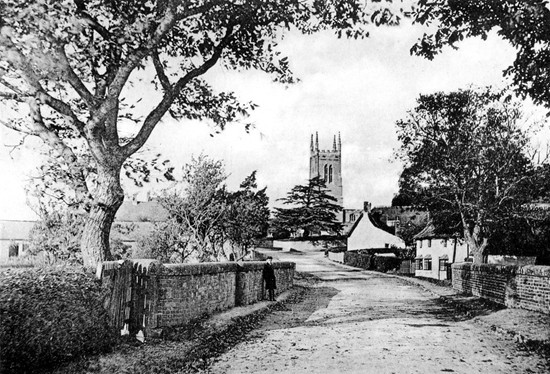 |
|
THE
POST OFFICE FIRE
One of the biggest fires in Edenham broke out during the night of Friday 21st May 1915 in the village post office with a house and grocery shop attached
(pictured above on the left). The alarm was raised by Mrs Smith, wife of the sub-postmaster John
Smith, who tried to telephone for help. The call got through to the fire station at Bourne but they received no message because by then, Mrs Smith had been forced to give up because of the fumes that threatened to suffocate her. Messengers from the village eventually reached the fire station but when the brigade arrived the premises were burning furiously and the buildings were gutted with only the outside walls remaining.
The countryside was lit up for several miles around at the height of the blaze. Mr Smith made strenuous efforts to salvage documents and equipment from the post office and although he managed to rescue the cashbox and contents, record books and supplies of postage stamps and postal orders were destroyed together with the telephone apparatus.
The cost of the damage was put at £2,000 (£94,000 at today's
value) but the cause of the outbreak was unknown although the fire is thought to have started near the cellar in an area where highly inflammable goods were stored. The village reading room which was situated on one side of the shop premises and underneath the same roof was also damaged and the blaze cut off telephone communications from the village for several
days.
|
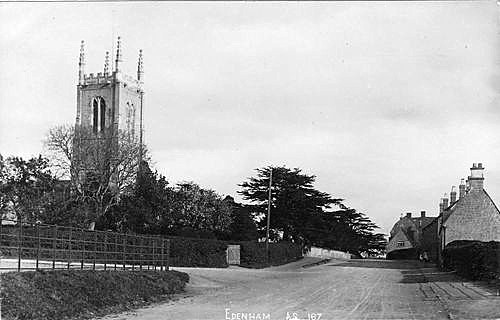 |
|
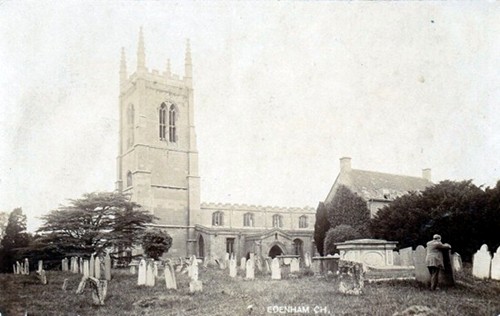 |
|
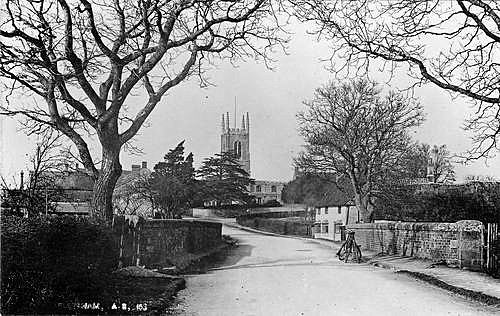 |
|
Three views of the church and main street at Edenham
(above) from picture postcards
taken by Ashby Swift, the Bourne photographer, around 1910. |
|
 |
|
Picture postcard of Edenham sold by
William Pearce of Bourne, also circa 1910. |
|
 |
|
The Five Bells Inn is depicted above in a postcard view by the
Bourne photographer William Redshaw, taken in 1905 with his
characteristic group of people, in this case, children from the
village who no doubt needed little persuasion to pose for him.
They may even have been attending the school nearby and allowed
out of the classroom to be in the picture because the arrival of a
photographer at that time was an unusual event.
The photographs below is also from a postcard view taken by
William Redshaw circa 1920. |
|
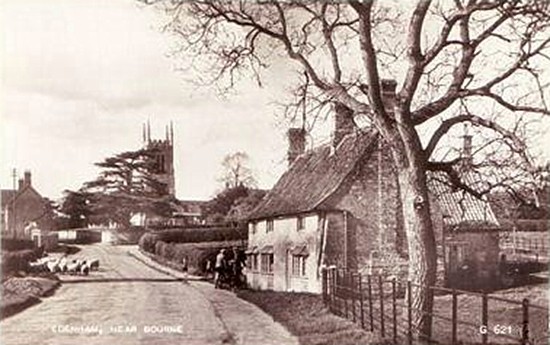 |
|
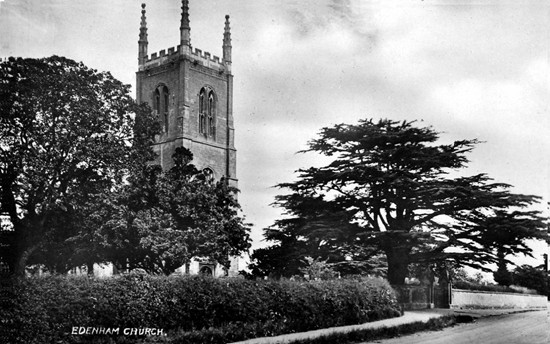 |
|
Another postcard view from circa 1920. |
|
 |
|
The main street at
Edenham taken
around 1930 by an unknown photographer
for a picture postcard. |
|
|
FROM THE ARCHIVES |
|
A fair held at Edenham, near Grimsthorpe, within 2
miles of Bourne, for all manner of stock, horses, beast, sheep and
merchandise, upon Tuesday being the 11th October next, before St Luke
and every Thursday before St George, both of which fairs will be kept on
those days for ever.
- public notice in the Stamford Mercury, Thursday 26th July 1716. An inquest was held at Edenham, near Bourne, by
Samuel Edwards, Gent., coroner, on the body of Wright Speed, who died on
Saturday 14th June in consequence of having that morning by mistake
taken a quantity of arsenic mixed with brimstone. This dreadful poison
was unintentionally administered to the deceased by his mother, whose
feelings on being the innocent cause of her son's death can more easily
be imagined than described. Verdict, poisoned inadvertently by mistake.
Medical assistance was procured soon after the mistake had been
discovered, but the poison was then too deeply lodged in the intestines
to be removed.
- news report from the Stamford Mercury, Friday 20th June 1823.
An inquest was held lately at Edenham, by S Edwards, Gent, coroner,
on the body of a man named Sims, a labourer in the employ of Mr Hodgkin,
of that place, who was riding in one of his master's carts on the Bourne
road when he accidentally fell over the side and one of the wheels
passing over his body, injured him so much as to occasion his death on
the same night. Verdict, accidental death. - news report from the
Stamford Mercury, Friday 4th November 1825.
A dreadful accident happened lately to a young gentleman named
Ashton, a pupil of Mr Henry Hodgkin, of Edenhan, near Bourne. He had
been employed frightening the crows from newly-sown wheat and had
returned home and was leaning over his gun at the barn door when it by
some accident went off and lodged the whole of its contents in his side.
The sufferer was immediately carried to his bed and a messenger
despatched to Mr G O Munton, surgeon, of Bourne, who promptly arrived on
the spot. Mr M extracted from the side of Mr Ashton the charge of shot
which had carried with it a portion of his shirt, drawers and trousers,
in which it was embedded like a cartridge. Fears were entertained for a
considerable time the the accident would prove fatal; but, although Mr A
has not yet been able to leave his bed, he is now progressing towards
convalescence. His situation has indeed been a perilous one and but for
the skill and duty of his medical attendants, his worldy prospects
(which we understand are flattering) would in all probability have been
at an end. - news report from the Stamford Mercury, Friday 18th
November 1842. |
REVISED JUNE 2014
See also
Benches
and pews George William Wilson

Go to:
Main Index Villages
Index
|
